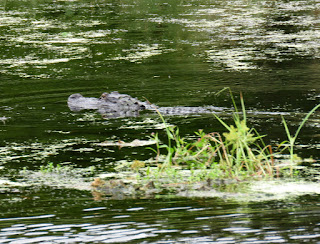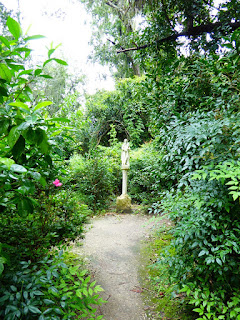Tuesday the 29th we visited Magnolia Plantation &
Gardens. It used to be a lucrative Rice Fields Plantation.
From their website: “Magnolia Plantation has been selected as one of
"America's Most Beautiful Gardens" (Travel + Leisure Magazine), and
is the only garden honored with this distinction in the State of South
Carolina.
Founded in 1676 by the Drayton family, Magnolia Plantation
has survived the centuries and witnessed the history of our nation unfold
before it from the American Revolution through the Civil War and beyond. It is
the oldest public tourist site in the Lowcountry, and the oldest public gardens
in America, opening its doors to visitors in 1870 to view the thousands of
beautiful flowers and plants in its famous gardens. So join us here at Magnolia
Plantation to experience the beauty of its gardens and its rich history today.”
It is a very large and beautiful Plantation, but of course
this time of year is not the height of seeing tons of things blooming. Spring would be optimal viewing.
We started out with the Nature Train (about 45 minutes) to
get a nice overview of the grounds. There was only one other couple on the
train. We saw a few gators and some Wood Ducks. There were tons of Peacocks
everywhere. We went by the old slave cabins and the smokehouse where they cured
the meat. We learned that the green stuff on the ponds is Duckweed. They don't try to get rid of it because the ducks love it. The Alligators however, are annoyed by it and often can be seen trying to shake it off.
peacock by the ticket booth
views from the train ride
Wood Ducks
slave cabins - 2 families per cabin
smokehouse where they cured the meats
large Oak Tree
white peacock
this is Bubbette - we didn't see her mate Bubba
The train left us at the Magnolia House. We walked around
the back and walked to the Nature Boat tour (also 45 minutes) We were the only
2 on the tour. We saw a ton of birds and gators on the tour. The guide was
interesting, but he talked non-stop and we were more interested in looking for
critters. We did see 2 Bald Eagles, lots of Great Blue Herons, Ibis, Great
White Egrets, Little Blue Herons, Green Herons, a Least Bittern, Anhingas,
Pied-billed Grebes, a Kingfisher, Snowy Egrets and lots of families of Common
Gallinules. (nothing new, but always fun to see them)
Magnolia Plantation House
front stairs
gardens out front
lots of peacocks on the verandas
back of the house
boat dock
Captain Dick
Anhinga
Great Blue Heron
Egrets
Great Blue Heron
Anhinga
Great Blue Heron
Egrets
Great Blue Heron
Anhinga
gator
Least Bittern
Bald Eagles
After the boat tour, we walked around some of the gardens
and climbed the observation tower.
We saw some Wood Ducks. Finally! (one male and 2 females)
Wood Ducks
Wood Ducks and a Gallinule
gator on the left & 3 Wood Ducks (easier to see in a larger photo)
Observation Tower
Tri-colored Heron
Carolina Wren
me on the bridge
Bamboo Garden
Greg
Greg on the bridge next to the tree growing up through it
me
Little Blue Heron
Then, it was time for lunch at the Peacock Café. I had a
tasty Chicken Cordon Bleu wrap and Greg had a Chicken Caesar Wrap and we shared
a brownie.
Peacock Cafe
ponies and a mule by the Cafe
Peacock in the garden
Then, we walked the many trails through the gardens and up and over pretty bridges and along ponds.
reproduction of the Rice Barge that took products to Charleston
Greenhouses
Great-crested Flycatcher
Great-crested Flycatcher
Great-crested Flycatcher
Great-crested Flycatcher
Nature Train
Our last stop was at the Audubon Boardwalk on the other side
of the Plantation. We drove and parked over by it and spent the rest of the
afternoon there. The water level was pretty high with all the rain we got
yesterday. There were areas where it was almost as high as the boardwalk. We
heard and saw a lot birds in this area. We also came across a small cemetery
where some of the slaves were buried.
Music of the Swamp - sculptures
nesting boxes for Wood Ducks
boardwalk
Common Gallinule
path between the boardwalks
Greg on the trail
White Ibis
White Ibis
mushrooms
Cypress knees
Pied-billed Grebe
large alligator sunning on the ramp
small alligator & turtle sunning together
immature Little Blue Heron
Downy Woodpecker
Downy Woodpecker
Eastern Kingbirds
Black-capped Chickadee
You can tour about 10 rooms in the Plantation House, but we
opted not to do that. (30 – 45 minute tour). They also offer another tour -
From Slavery to Freedom: The Magnolia Cabin Project Tour (45 minutes) It’s a
tour of the 5 slave cabins & history of slaves from different time periods.
What was once called the Old African American Cabin is now
the Gilliard Garden Center. The center is named for Tena Gilliard. She lived in
this structure and acted as the official "greeter" for Magnolia up
until the 1940's. She was born shortly after the Civil War ended. C.N. Hastie
named a beautiful camellia for her, which is registered in the American
Camellia Society and the International Camellia Society, and can be seen on a
path near the Plantation House. There were plants for sale here.
As we were walking around the grounds we noticed that the
trains and the boat tours were now running full. We were lucky we started early
in the day. It was cool out this morning and still a bit “drippy” and misty on
and off and I think it deterred people from going out earlier. We didn’t leave
until after 3:00 and if we had done all there was to do there it would have
been another 2 or 3 hours.
It was a very nice day out and about communing with nature.
Tomorrow, we head out to Columbia, SC. We are leaving the Lowcountry and now headed Upcountry.
Savannah and Charlestown bookend the Lowcountry. The Low Country & Antebellum (pre-Civil War) area is around a
200-mile stretch of coastal South Carolina and Georgia. We have seen wide, flat
expanses of marsh grass, live oak trees layered with “Spanish Moss” and lot of
bodies of water—tidal marshes, rivers, estuaries, and the Atlantic Ocean. Now
to see what Upcountry has to offer!
The northwest corner of SC, in the foothills of the Blue Ridge Mountains is considered Upcountry. (midway between Charlotte, NC and Atlanta, GA.)
































































































































































































































